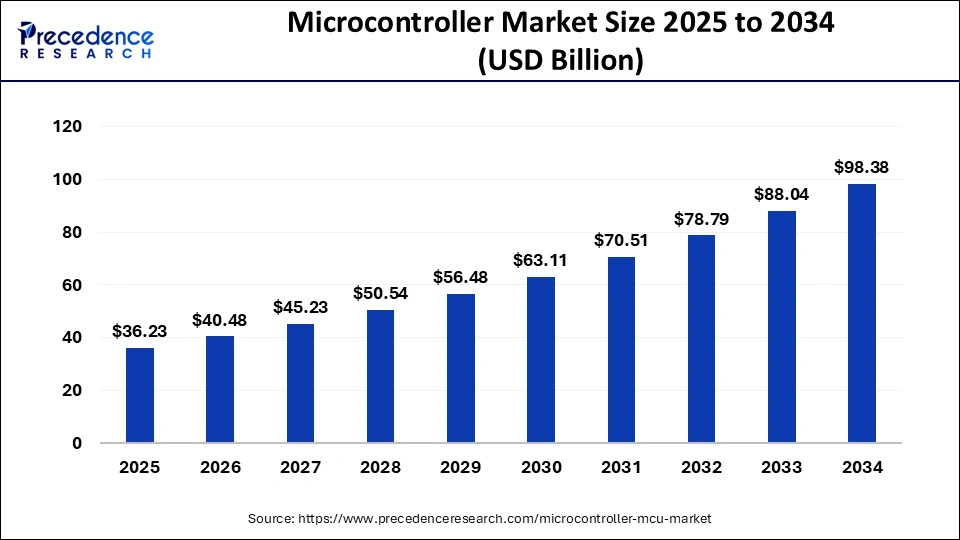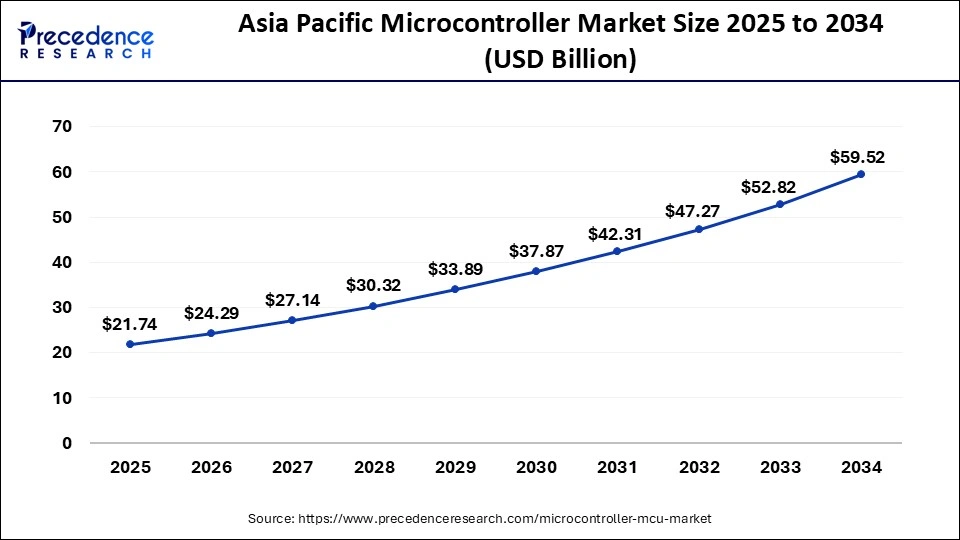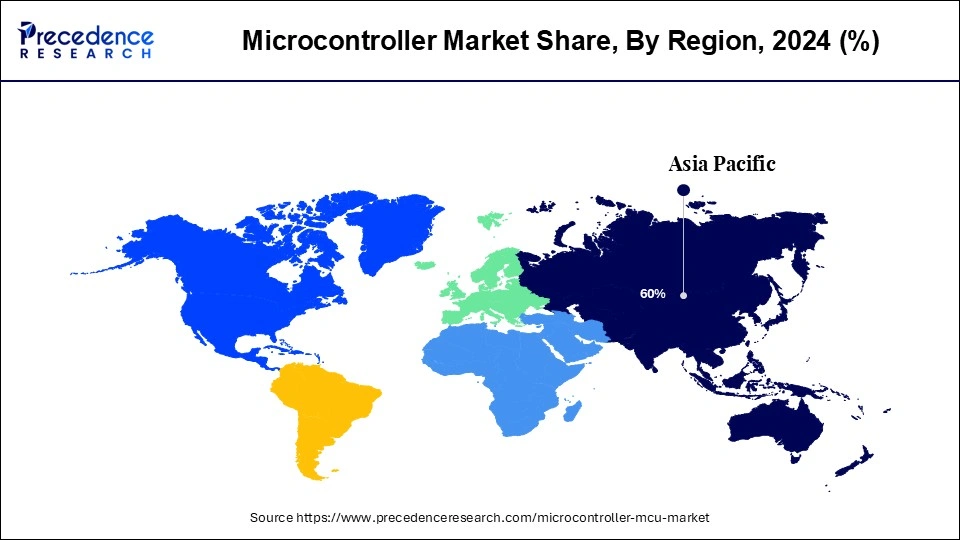October 2024
The global microcontroller (MCU) market size accounted for USD 36.23 billion in 2025 and is forecasted to reach around USD 98.38 billion by 2034, accelerating at a CAGR of 11.75% from 2025 to 2034. The Asia Pacific microcontroller (MCU) market size surpass USD 21.74 billion in 2025 and is expanding at a CAGR of 11.83 % during the forecast period. The market sizing and forecasts are revenue-based (USD Million/Billion), with 2024 as the base year.
The global microcontroller (MCU) market size was valued at USD 32.42 billion in 2024 and is predicted to increase from USD 36.23 billion in 2025 to approximately USD 98.38 billion by 2034, expanding at a CAGR of 11.74% from 2025 to 2034.

The Asia Pacific microcontroller (MCU) market size expected to reach around USD 19.45 billion in 2024 and is predicted to be worth around USD 59.52 billion by 2034, at a CAGR of 11.83% from 2025 to 2034.

Asia Pacific dominated the microcontroller market with the largest share in 2024. This is mainly due to its robust electronics industry, leading to the increased production of microcontrollers. There is rapid industrialization, leading to heightened adoption of microcontrollers in manufacturing and industrial applications. China is the world’s largest producer of vehicles, followed by Japan, India, and South Korea. As vehicle production increases, so does the demand for microcontrollers, as they are essential in electric vehicles and automotive electronic components.

Europe is the other most prominent revenue contributor to the global microcontroller market because of significant presence of automotive and its parts manufacturers. Furthermore, significant demand of luxury cars along with the presence of manufacturing plants of leading automobile players in the region drives the demand for MCUs in the region.
The prominent growth in consumer electronics, automotive, and healthcare industries attributed to the rising demand for microcontrollers units (MCUs). MCU are majorly used in devices that require high degree of control utilized by the users. The automotive industry seeks an escalating demand of luxury cars that uses advanced microcontrollers to control various advanced features incorporated in the car, thereby propelling the industry growth of automotive sector in the market. Furthermore, a spike in the sales of electric vehicles (EVs) especially in the developed regions expected to boost the growth of microcontrollers in the coming years. The growth of EV is also supported by the governments of various regions, as it remarkably helps in reducing the carbon footprint.
Recently, the MCU market witnesses an increased demand for Internet of Things (IoT) MCUs owing to spreading web of connected devices encompasses televisions, smartphones, home appliances, tablets, smart meters, gaming consoles, and security systems. By leveraging this ever-growing web of devices, the demand for IoT microcontroller units expected to propel. Increasing competition among the market players has notably reduced the price of microcontrollers that anticipated to further fuel its demand in the coming years. The reducing average selling prices coupled with high demand of MCUs from major application areas also boost the growth of the market.
| Report Highlights | Details |
| Market Size by 2034 | USD 98.38 Billion |
| Market Size in 2025 | USD 36.23 Billion |
| Market Size in 2024 | USD 32.42 Billion |
| Growth Rate from 2025 to 2034 | CAGR of 11.74% |
| Largest Market | Asia Pacific |
| Base Year | 2024 |
| Forecast Period | 2025 to 2034 |
| Segments Covered | Product, Application, Architecture, Memory, and Region |
| Regions Covered | North America, Europe, Asia-Pacific, Latin America, and Middle East & Africa |
The 32-bit segment accounted largest revenue share of around 41% in 2024. The 8-bit microcontroller technology lowers the material costs and simplifies the product design. The developers select the controllers on the basis of their processing capability, power consumption, and degree of interfacing required. An 8-bit MCU comprises of software simplicity, low gate count, and lesser complexity that decrease its cost compared to other types of microcontrollers. On the other side, the 8-bit MCU predicted to witness slower growth due to its processing speed that generally runs at 8 MHz and does not have considerable internal Random-Access Memory (RAM).
16-bit and 32-bit MCUs are used on larger scale in the automotive industry owing to their specific technological requirements. However, the 32-bit MCU segment anticipated to register the highest growth rate during the forecast period. 32-bit MCUs have higher processing power compared to their counterparts and consume less amount of power. Furthermore, increasing popularity of 32-bit MCUs because of significant decline in the per unit price expected to further propel the growth of the segment.
The global microcontroller market is bifurcated into consumer electronics, automotive, medical devices, industrial, and military & defense. The automotive sector is expected to witness growth 10.1% over the forecast period. Introduction to Advanced Driver Assistance System (ADAS) and Adaptive Cruise Control (ACC) accounted to drive the automotive segment prominently over the analysis period. ADAS technology applies image sensors to improve the driver safety by offering features that include parking assistance, lane departure warning, and collision avoidance systems. The stringent regulatory norms for improving the road safety for pedestrians and drivers predicted to further propel the growth of the segment.
The consumer electronics and telecom application segment accounted the largest revenue share of around 45.5% in 2024. The growth is attributed to the miniaturization of consumer electronic devices along with escalating adoption of televisions, cameras, microwave ovens, and washing machines among other consumer electronic devices.
Medical devices also anticipated to exhibit lucrative growth for microcontroller over the coming years owing to increasing demand for accuracy in medical procedures, government support for medical automation, technological advancements, and increasing research & development (R&D) investments for the development of MCUs used in advanced medical equipment.
The global microcontroller (MCU) market observes intense competition among market players. Leading five market players occupied nearly half of the market value that drives the market towards consolidation. Brand name and loyalty are the key factors behind the remarkable success of these players in the global market. Other than this, market participants actively focus towards partnership and collaboration to develop new and advanced products.
On 21st May 2025, a developer of neuromorphic processors, Innatera, made an announcement about its project Pulsar. That is the company's first commercially available microcontroller, which will offer intelligence like the human brain into edge devices. Pulsar is able to deliver up to 100 times lower latency, along with 500 times less energy consumption than traditional AI processors. (Source: https://insidehpc.com )
On 11th March 2025, Texas Instruments introduced the smallest microcontroller unit in the world. While expanding its comprehensive arm-Cortex. Which is nearly the size of a black pepper flake, the wafer chip-scale package. This chip can be utilized to optimize board space in applications like medical wearables and personal electronics, which further supports performance efficiency. (Source: https://www.ti.com)
On 6th May 2024, IIT Madras-based startup, known as Mindgrove Technologies, has introduced secure IoT, the first microcontroller chip which is totally developed in India and 30% cheaper than other chips, and able to power electronic devices efficiently with various ranges from smart wearables to large city infrastructure. The chip provides versatility, efficiency, and security as well for a range of devices. (Source: https://www.indiatoday.in )
This research study comprises complete assessment of the market by means of far-reaching qualitative and quantitative perceptions, and predictions regarding the market. This report delivers classification of marketplace into impending and niche sectors. Further, this research study calculates market size and its development drift at global, regional, and country from 2020 to 2032. This report contains market breakdown and its revenue estimation by classifying it on the basis ofproduct, application, and region:
By Product
By Application
By Architecture
By Memory
By Region
For inquiries regarding discounts, bulk purchases, or customization requests, please contact us at sales@precedenceresearch.com
No cookie-cutter, only authentic analysis – take the 1st step to become a Precedence Research client
October 2024